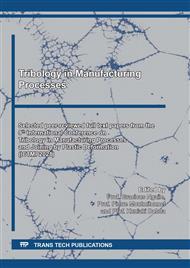[1]
K.-H. Brensing and B. Sommer, Steel Tube and Pipe Manufacturing Process, Available at: https://pdfs.semanticscholar.org/1e72/45a6f6c8e88a7db893d5b311feb5f8083d7d.pdf?_ga=2.94978270.356729499.1577025450-670639474.1577025450.
Google Scholar
[2]
K. Komori, Simulation of Mannesmann piercing process by the three-dimensional rigid-plastic finite-element method, Int. J. Mech. Sci., 47, 12 (2005) 1838–1853.
DOI: 10.1016/j.ijmecsci.2005.07.009
Google Scholar
[3]
E. Ceretti, 2D Simulation and validation of rotary tube piercing process, in : S. Ghosh, J. C. Castro and J. K. Lee (Eds), Proc. NUMIFORM 2004 (Colombus, OH, USA, 13-15 June 2004), AIP Conference Proceedings, vol. 712, p.1154–1159.
DOI: 10.1063/1.1766684
Google Scholar
[4]
E. Ceretti, C. Giardini, and F. Brisotto, Development of a simulation model of the rotary tube piercing process and FEM application to improve the quality of seamless tubes, in : P. Bariani (Ed), Proc.8th Int. Conf. Tech. Plast. (Verona, Italy, 9-13 October 2005), pp.281-282.
Google Scholar
[5]
E. Ceretti, C. Giardini, and A. Attanasio, 3D Simulation and validation of tube piercing process, in : J.M.A. Cesar de Sa and A.D. Santos (Eds), Proc. NUMIFORM 2007 (Porto, Portugal, 17-21 June 2007), AIP Conference Proceedings, vol. 908, p.413–418.
DOI: 10.1063/1.2740846
Google Scholar
[6]
S. Fanini, A. Ghiotti, and S. Bruschi, Evaluation of fracture initiation in the Mannesmann piercing process, in: E. Cueto, F. Chinesta (Eds), Proc. 10th Esaform Conf. (Zaragoza, Spain, 18-20 April 2007), AIP Conference Proceedings, vol. 907, p.709–714.
DOI: 10.1063/1.2729596
Google Scholar
[7]
S. Fanini, A. Ghiotti, and S. Bruschi, Prediction of the fracture due to Mannesmann effect in tube piercing, in : J.M.A. Cesar de Sa and A.D. Santos (Eds), Proc. NUMIFORM 2007 (Porto, Portugal, 17-21 June 2007), AIP Conference Proceedings, vol. 908, p.1407–1412.
DOI: 10.1063/1.2741006
Google Scholar
[8]
Y. Chastel, A. Diop, S. Fanini, P.-O. Bouchard, and K. Mocellin, Finite element modeling of tube piercing and creation of a crack, in : P. Boisse, F. Morestin, E. Vidal-Sallé (Eds), Proc. 11th ESAFORM Conference (Lyon, France, 23-25 April 2008), vol. 1, pp.355-358.
DOI: 10.1007/s12289-008-0068-2
Google Scholar
[9]
S. Fanini, Modelling of the Mannesmann effect in tube piercing, PHD Dissertation, Università degli Studi di Padova, (2008).
Google Scholar
[10]
A. Ghiotti, S. Fanini, S. Bruschi, and P.F. Bariani, Modelling of the Mannesmann effect, CIRP Ann., 58, 1 (2009) 255–258.
DOI: 10.1016/j.cirp.2009.03.099
Google Scholar
[11]
M.M. Skripalenko, V.E. Bazhenov, B.A. Romantsev, M.N. Skripalenko, T.B. Huy, and Y.A. Gladkov, Mannesmann piercing of ingots by plugs of different shapes, Mater. Sci. Technol. 32, 16 (2016) 1712–1720.
DOI: 10.1080/02670836.2016.1145840
Google Scholar
[12]
B.A. Romantsev, M.M. Skripalenko, T.B. Huy, M.N. Skripalenko, Y.A. Gladkov, and A.A. Gartvig, Computer simulation of piercing in a four-high screw rolling mill, Metallurgist, 61, 9–10 (2018) 729–735.
DOI: 10.1007/s11015-018-0556-7
Google Scholar
[13]
M.M. Skripalenko, B.A. Romantsev, S.P. Galkin, M.N. Skripalenko, L.M. Kaputkina, and T.B. Huy, Prediction of the fracture of metal in the process of screw rolling in a two-roll mill, Metallurgist, 61, 11–12 (2018) 925–933.
DOI: 10.1007/s11015-018-0588-z
Google Scholar
[14]
V.P. Romanenko, P.L. Alekseev, E.A. Kharitonov, A.A. Yandimirov, and A.A. Sevastyanov, Study of the temperature regimes in the heating and piercing of steel ingots to obtain thick-walled shells, Metallurgist, 55, 1–2 (2011) 28–33.
DOI: 10.1007/s11015-011-9388-4
Google Scholar
[15]
V.P. Romanenko and D.V. Sizov, Evaluating the adequacy of a mathematical model of the piercing of a billet into an ultra-thick-walled shell on a two-high rotary rolling mill, Metallurgist, 57, 9–10 (2014) 830–836.
DOI: 10.1007/s11015-014-9809-2
Google Scholar
[16]
Z. Zhang, D. Liu, Y.H. Yang, Y. Zheng, Y.H. Pang, J.G. Wang and H.P. Wang, Explorative study of rotary tube piercing process for producing titanium alloy thick-walled tubes with bi-modal microstructure, Arch. Civ. Mech. Eng., 18, 4, (2018) 1451–1463.
DOI: 10.1016/j.acme.2018.05.005
Google Scholar
[17]
A. Murillo-Marrodán, E. Garcia and F. Cortés, Modelling of the cone-type rotary piercing process and analysis of the seamless tube longitudinal shear strain using industrial data, Proc. 22nd Int. ESAFORM Conf., Vitoria-Gasteiz, Spain, 8-10 May 2019, AIP Publishing Proc., vol. 2113, paper 040003.
DOI: 10.1063/1.5112537
Google Scholar
[18]
L. Fourment, J.-L. Chenot and K. Mocellin, Numerical formulations and algorithms for solving contact problems in metal forming simulation, Int. J. Num. Meth. Engg 46, 9 (1999) 1435-1462.
DOI: 10.1002/(sici)1097-0207(19991130)46:9<1435::aid-nme707>3.0.co;2-9
Google Scholar
[19]
M. Ramadan, L. Fourment, H. Digonnet, Fast resolution of incremental forming processes by the Multi-Mesh method. Application to cogging, Int. J. Mater. Forming 7, 2 (2014) 207-219.
DOI: 10.1007/s12289-012-1121-8
Google Scholar


